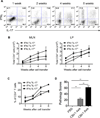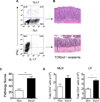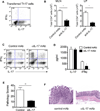Th17 cells induce colitis and promote Th1 cell responses through IL-17 induction of innate IL-12 and IL-23 production
- PMID: 21531892
- PMCID: PMC3249225
- DOI: 10.4049/jimmunol.1001454
Th17 cells induce colitis and promote Th1 cell responses through IL-17 induction of innate IL-12 and IL-23 production
Abstract
Both Th1 and Th17 cells have been implicated in the pathogenesis of inflammatory bowel disease and experimental colitis. However, the complex relationship between Th1 and Th17 cells and their relative contributions to the pathogenesis of inflammatory bowel disease have not been completely analyzed. Although it has been recently shown that Th17 cells can convert into Th1 cells, the underlying in vivo mechanisms and the role of Th1 cells converted from Th17 cells in the pathogenesis of colitis are still largely unknown. In this study, we report that Th17 cells from CBir1 TCR transgenic mice, which are specific for an immunodominant microbiota Ag, are more potent than Th1 cells in the induction of colitis, as Th17 cells induced severe colitis, whereas Th1 cells induced mild colitis when transferred into TCRβxδ(-/-) mice. High levels of IL-12 and IL-23 and substantial numbers of IFN-γ(+) Th1 cells emerged in the colons of Th17 cell recipients. Administration of anti-IL-17 mAb abrogated Th17 cell-induced colitis development, blocked colonic IL-12 and IL-23 production, and inhibited IFN-γ(+) Th1 cell induction. IL-17 promoted dendritic cell production of IL-12 and IL-23. Furthermore, conditioned media from colonic tissues of colitic Th17 cell recipients induced IFN-γ production by Th17 cells, which was inhibited by blockade of IL-12 and IL-23. Collectively, these data indicate that Th17 cells convert to Th1 cells through IL-17 induction of mucosal innate IL-12 and IL-23 production.
Figures





Similar articles
-
Interleukin-12 converts Foxp3+ regulatory T cells to interferon-γ-producing Foxp3+ T cells that inhibit colitis.Gastroenterology. 2011 Jun;140(7):2031-43. doi: 10.1053/j.gastro.2011.03.009. Epub 2011 Mar 17. Gastroenterology. 2011. PMID: 21419767 Free PMC article.
-
Microbiota Metabolite Butyrate Differentially Regulates Th1 and Th17 Cells' Differentiation and Function in Induction of Colitis.Inflamm Bowel Dis. 2019 Aug 20;25(9):1450-1461. doi: 10.1093/ibd/izz046. Inflamm Bowel Dis. 2019. PMID: 30918945 Free PMC article.
-
TGF-β converts Th1 cells into Th17 cells through stimulation of Runx1 expression.Eur J Immunol. 2015 Apr;45(4):1010-8. doi: 10.1002/eji.201444726. Epub 2015 Feb 11. Eur J Immunol. 2015. PMID: 25605286 Free PMC article.
-
Synergy of IL-23 and Th17 cytokines: new light on inflammatory bowel disease.Neurochem Res. 2010 Jun;35(6):940-6. doi: 10.1007/s11064-009-0091-9. Epub 2009 Nov 14. Neurochem Res. 2010. PMID: 19915978 Free PMC article. Review.
-
The Pathogenicity and Synergistic Action of Th1 and Th17 Cells in Inflammatory Bowel Diseases.Inflamm Bowel Dis. 2023 May 2;29(5):818-829. doi: 10.1093/ibd/izac199. Inflamm Bowel Dis. 2023. PMID: 36166586 Review.
Cited by
-
Mechanisms of lymphoid depletion in bowel obstruction.Front Physiol. 2022 Sep 21;13:1005088. doi: 10.3389/fphys.2022.1005088. eCollection 2022. Front Physiol. 2022. PMID: 36213246 Free PMC article.
-
Escherichia coli adhesion protein FimH exacerbates colitis via CD11b+CD103- dendritic cell activation.Front Immunol. 2023 Nov 22;14:1284770. doi: 10.3389/fimmu.2023.1284770. eCollection 2023. Front Immunol. 2023. PMID: 38077339 Free PMC article.
-
The Th17 pathway and inflammatory diseases of the intestines, lungs, and skin.Annu Rev Pathol. 2013 Jan 24;8:477-512. doi: 10.1146/annurev-pathol-011110-130318. Epub 2012 Nov 15. Annu Rev Pathol. 2013. PMID: 23157335 Free PMC article. Review.
-
JunB promotes Th17 cell identity and restrains alternative CD4+ T-cell programs during inflammation.Nat Commun. 2017 Aug 21;8(1):301. doi: 10.1038/s41467-017-00380-3. Nat Commun. 2017. PMID: 28824171 Free PMC article.
-
Intravenous vs intraperitoneal mesenchymal stem cells administration: what is the best route for treating experimental colitis?World J Gastroenterol. 2014 Dec 28;20(48):18228-39. doi: 10.3748/wjg.v20.i48.18228. World J Gastroenterol. 2014. PMID: 25561790 Free PMC article.
References
-
- Powrie F, Leach MW, Mauze S, Menon S, Caddle LB, Coffman RL. Inhibition of Th1 responses prevents inflammatory bowel disease in scid mice reconstituted with CD45RBhi CD4+ T cells. Immunity. 1994;1:553–562. - PubMed
-
- Fuss IJ, Neurath M, Boirivant M, Klein JS, de la Motte C, Strong SA, Fiocchi C, Strober W. Disparate CD4+ lamina propria (LP) lymphokine secretion profiles in inflammatory bowel disease. Crohn's disease LP cells manifest increased secretion of IFN-gamma, whereas ulcerative colitis LP cells manifest increased secretion of IL-5. J Immunol. 1996;157:1261–1270. - PubMed
-
- Yen D, Cheung J, Scheerens H, Poulet F, McClanahan T, McKenzie B, Kleinschek MA, Owyang A, Mattson J, Blumenschein W, Murphy E, Sathe M, Cua DJ, Kastelein RA, Rennick D. IL-23 is essential for T cell-mediated colitis and promotes inflammation via IL-17 and IL-6. J Clin Invest. 2006;116:1310–1316. - PMC - PubMed
-
- Elson CO, Cong Y, Weaver CT, Schoeb TR, McClanahan TK, Fick RB, Kastelein RA. Monoclonal anti-interleukin 23 reverses active colitis in a T cell-mediated model in mice. Gastroenterology. 2007;132:2359–2370. - PubMed
Publication types
MeSH terms
Substances
Grants and funding
- AI083484/AI/NIAID NIH HHS/United States
- DK064400/DK/NIDDK NIH HHS/United States
- R24 DK064400/DK/NIDDK NIH HHS/United States
- RR-20136/RR/NCRR NIH HHS/United States
- C06 RR020136/RR/NCRR NIH HHS/United States
- R01 DK079918/DK/NIDDK NIH HHS/United States
- R01 NS057563/NS/NINDS NIH HHS/United States
- DK079918/DK/NIDDK NIH HHS/United States
- P01 DK071176/DK/NIDDK NIH HHS/United States
- NS50655/NS/NINDS NIH HHS/United States
- R21 AI083484-03/AI/NIAID NIH HHS/United States
- R01 DK079918-05/DK/NIDDK NIH HHS/United States
- NS57563/NS/NINDS NIH HHS/United States
- DK071176/DK/NIDDK NIH HHS/United States
- R21 AI083484/AI/NIAID NIH HHS/United States
- R01 NS050655/NS/NINDS NIH HHS/United States
LinkOut - more resources
Full Text Sources
Other Literature Sources
Molecular Biology Databases

